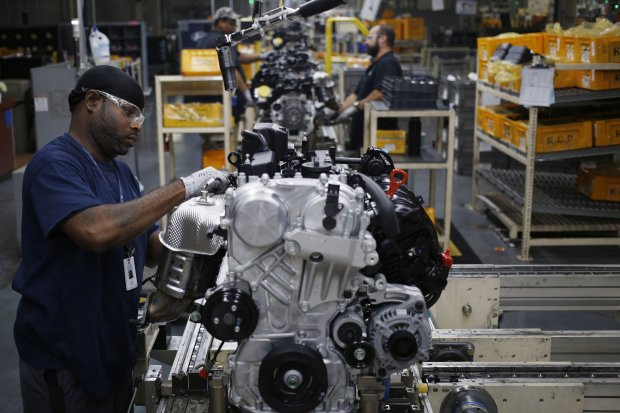WHY AREN´T COMPANIES SPENDING MORE? / THE WALL STREET JOURNAL
Why Aren’t Companies Spending More?
The tax cut gave companies ample means to significantly increase capital spending, but so far they don’t seem to be
By Justin Lahart
An employee assembles an engine on the production line at the Hyundai Motor Manufacturing Alabama facility in Montgomery, Ala. Photo: Luke Sharrett/Bloomberg News
The renaissance in capital spending the tax cut was supposed to bring about isn’t showing up in the economic data.
The Commerce Department on Friday reported that orders for durable goods—long-lasting equipment like tractors and machinery—dropped 1.7% in April from a month earlier. That decline was driven by a drop in aircraft orders, however. Orders for nondefense capital goods excluding aircraft, which economists follow closely to gauge where capital spending is going, increased by 1% to a seasonally adjusted $67.3 billion after falling 1.2% in March.
These orders have been hovering around the same level for the past half year, though. Given how much money the corporate tax cut is providing companies, and how much money is being repatriated from overseas as a result of the tax law’s provisions, this is something of a surprise.
It also seems at odds with what companies are saying. U.S. chief financial officers surveyed in the first quarter by Duke University’s Fuqua School of Business said they expected capital spending at their companies would be up an average of 11% over the next 12 months from the previous year. Capital spending at S&P 500 companies was up smartly in the first quarter, according to a Credit Suisse analysis.
So what is going on?
CAPITAL IDEA
Chief financial officers' expected change in capital spending over the next 12 months
Source: Duke University
For starters, it is important to remember that orders precede shipments. The gains in capital spending companies registered in the first quarter in many cases reflected plans put in place last year—before they had any clear sense about whether the tax cut would pass. Multinationals also don’t limit their capital spending to the U.S. Finally, there are areas of capital spending, such as software, not included in the durable-goods report.
It also could be that investors prefer the extra money from the corporate tax cut be returned to shareholders through dividends and buybacks. Some expansion-minded chief executives might prefer making acquisitions, which are immediately accretive to earnings, rather than embarking on costly projects that can take years to pay off. So far this year there have been $1.5 trillion in merger and acquisition deals worth $1 billion or more globally, according to a recent CreditSights analysis. That compares to $759 billion over the same period last year.
Even given those conditions, though, it seems like companies ought to be increasing capital spending by more. A tight labor market is giving them a good reason to try to boost their existing workers’ productivity and the tax cut has given them even more means to do it.
Their hesitation is unsettling.


0 comments:
Publicar un comentario